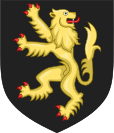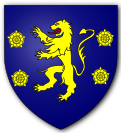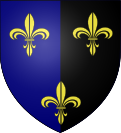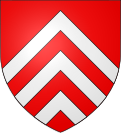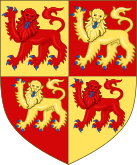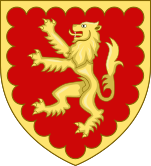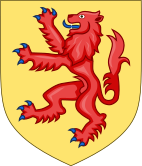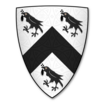List of rulers in Wales
| History of Wales |
|---|
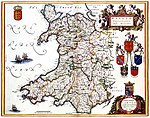 |
This is a list of rulers in Wales (Welsh: Cymru; and neighbouring regions) during the Middle Ages, between c. 400s–1500s. The rulers were monarchs who ruled their respective realms, as well as those who briefly ruled the Principality of Wales. These former territories are now within the boundaries of modern-day Wales and the neighbouring Welsh Marches in England (both in the United Kingdom).
Before the Conquest of Wales, completed in 1283, Wales consisted of several independent realms, the most important being Gwynedd, Powys, Deheubarth (originally Ceredigion, Seisyllwg and Dyfed) and Morgannwg (Glywysing and Gwent). Boundary changes and the custom of dividing patrimonies between heirs meant that few princes ever came close to ruling the whole of Wales.
The names of those known to have ruled over one or more areas are listed below. Boundaries changed frequently. The only person known to have ruled all of Wales as a modern territory was Gruffydd ap Llywelyn (c. 1010–1063), a Prince of Gwynedd who became King of Wales from 1055 to 1063. However, some Welsh Princes sporadically claimed the medieval title of "Prince of Wales" between the 13th to 15th centuries. The title remains in use but is usually given to heir apparents of English and British monarchs.
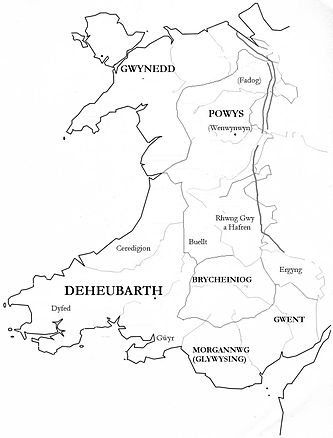
History of the medieval kingdoms in Wales
[edit]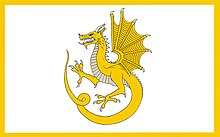
Wales during the medieval age was a land of kingdoms and dynasties. Petty kingdoms, such as Ceredigion and Gwent, were established some time after Britain ceased to be part of the Roman empire in the late 5th century. By the time of the Norman invasion of Wales in the 11th century, most of these realms were combined or incorporated into greater territories, thus making up the four major Kingdoms of Wales. Those Kingdoms were Gwynedd, Powys, Deheubarth, and Morgannwg. Unlike the others, Deheubarth was formed later by the merging of Ceredigion, Dyfed, and Ystrad Tywi. Some minor (petty) kingdoms stayed independent from the big four kingdoms, only to be taken over by the Anglo-Normans in the 13th century, such as Rhwng Gwy a Hafren, and Meirionnydd, and others. Of the major kingdoms, Powys' 13th century division of Wenwynwyn and Fadog were one of the final surviving Welsh dynasties until after the Edwardian conquest of Wales. Later, Owain Glyndŵr became the final Welsh ruler from royalty in Wales, he emerged in Powys Fadog during the early 15th century as a Prince of Wales.[1][2]
Welsh Kingdoms (400s–1000s)
[edit]Kings of Brycheiniog
[edit]- Anlach mac Cormac;[3]
- Brychan Brycheiniog ap Anlach (c. 400 or 470)[4][a]
- Tewdwr ap Rhain (c. 700);[6]
- Nowy (c. 725);[7]
- Gruffudd ap Nowy (c. 750).[8]
Kings and Princes of Ceredigion
[edit]- Ceredig ap Cunedda, c. 5th century (410);[2][9]
- Usai ap Ceredig (c. 450);[10]
- Serwyl ab Usai (c. 490);[11]
- Boddw ap Serwyl (c. 530);[12]
- Arthfoddw ap Boddw (c. 570);[13]
- Arthlwys ab Arthfoddw (c. 610);[14]
- Clydog ab Arthlwys (c. 650);[15]
- Seisyll ap Clydog, King of Seisyllwg (c. 690, Ceredigion and Ystrad Tywi);[16]
- Arthen ap Seisyll (d. 807);[17]
- Dyfnwallon ab Arthen (c. 750);[18]
- Meurig ap Dyfnwallon (c. 780);[19]
- Gwgon ap Meurig (d. 872).[20]
Kings and Princes of Dyfed
[edit]- Triffyn Farfog (c. 430)[21]
- Aergol Lawhir (c. 460)[22]
- Vortiporius[23]
- Cloten (c. 600, Gwlyddein ap Nowy ap Arthur)[24]
- Maredudd ap Tewdwr (d. 796)[25]
- Rhain ap Maredudd (d. 808)[26]
- Owain ap Maredudd (d. 811)[27]
- Triffyn ap Rhain (d. 814)[28]
- Hyfaidd ap Bleddri (d. 893)[29]
- Llywarch ap Hyfaidd (d. 904)[30]
- Rhodri ap Hyfaidd (d. 905)[31]
Kingdom of Gwynedd
[edit]Kings of Gwynedd
[edit]- Cunedda Wledig ap Edern (c. 370)[2][32]
- Einion Yrth ap Cunedda (Einion the Impetuous, c. 410)[33]
- Cadwallon Lawhir ap Einion (English: Cadwallon Long Hand, c. 440)[34]
- Maelgwn Hir ap Cadwallon (English: Maelgwn the Tall, Maelgwn Gwynedd, d. 547)[35]
- Rhun Hir ap Maelgwn (English: Rhun the Tall, c. 500)[36]
- Beli ap Rhun[37]
- Iago ap Beli (died c. 616)[38]
- Cadfan ap Iago (c. 565)[39]
- Cadwallon ap Cadfan (d. 634)[40]
- Cadafael ap Cynfeddw (English: Cadfael the Battle-Shirker)[41]
- Cadwaladr Fendigaid ap Cadwallon (English: Cadwaladr the Blessed, d. 664)[42]
- Idwal Iwrch ap Cadwaladr (Idwal Roebuck, c. 660)[43]
- Rhodri Molwynog ap Idwal (English: Rhodri the Bald and Gray, d. 754)[44]
- Caradog ap Meirion (d. 798, Prince of Rhos)[45]
- Cynan Dindaethwy ap Rhodri (d. 816)[46]
- Hywel ap Caradog[47]
- Merfyn Frych ap Gwriad (d. 844)[48]
Princes of Dogfeiling
[edit]- Dogfael ap Cunedda Wledig (c. 410)[49]
- Elno ap Dogfael (c. 440)[50]
- Glas ap Elno (c. 470)[51]
- Elgud ap Glas ap Elno (c. 500)[52]
- Elaeth ab Elgud (c. 530)[53]
- Meurig ap Elaeth (c. 570)[19]
Princes of Dunoding
[edit]- Dunod ap Cunedda Wledig (c. 400)[54]
- Eifion ap Dunod ap Cunedda (c. 430)[55]
- Dingad ap Eifion (c. 470)[56]
- Meurig ap Dingad (c. 500)[19]
- Eifion ap Meurig (c. 530)[55]
- Issac ap Eifion ap Meurig (c. 570)[57]
- Pobien Hen ap Isaac (c. 600)[58]
- Pobddelw ap Pobien Hen (c. 630)[58]
- Eifion ap Pobddelw (c. 670)[55]
- Brochwel ap Eifion (c. 700)[59]
- Eigion ap Brochwel ab Eifion (c. 730)[55]
- Ieuanawl ab Eigion (c. 770)[60]
- Caradog ap Ieuanawl (c. 800)[45]
- Blieddud ap Caradog (c. 830)[61]
- Cuhelyn ap Bleiddud (c. 870)[62]
Princes of Rhos
[edit]- Owain Ddantgwyn ap Einion Yrth (Rhos; c. 440)[63]
- Cynlas Goch ab Owain Gwyn (c. 470, Rhos)[64]
- St Einion (Llŷn) ap Owain (c. 470)[64]
- Maig ab Owain ap Cynlas (c. 500)[65]
- Cadal Crysban (c. 560, Crys-Halog)[66]
- Idgwyn ap Cadwal Crysbyn (c. 590)[67]
- Einion ab Idgwyn (c. 620)[33]
- Rhufon ap Einion ap Idgwyn (c. 650)[68]
- Hywel ap Rhufon (c. 680)[47]
- Meirion ap Hywel ap Rhufon (c. 710)[69]
- Hywel ap Caradog (c. 825, Hywel Farf-Fehinog)[70]
Princes of Rhufoniog
[edit]- Rhufon ap Cunedda Wledig (c. 400)[68]
- Breichiol (c. 830)[71]
- Môr ap Breichiol (c. 870)[72]
- Aeddan ap Môr (c. 900)[73]
- Morudd ab Aeddan (c. 930)[74]
- Môr ap Morudd (c. 970)[75]
Kingdom of Morgannwg
[edit]Kings of Ergyng
[edit]Kingdom of Ergyng, in Wales and on the border of what is now Herefordshire, England.[76]
- Peibio Clafrog ap Erb (c. 525), King of Ergyng[76]
- Cynfyn ap Peibio (c. 550)[77]
- Gwrfoddw[78]
- Gwrgan Fawr ap Cynfyn (c. 650)[79]
Kings of Ewyas
[edit]Regional Kingdom of Ewyas (Ewias) in Wales and Herefordshire, England.[80]
Kings of Glywysing
[edit]- Glywys ap Solor (c. 430)[82]
- Pawl Penychen (c. 465)[83]
- Mechwyn, ruler of Gorfynydd, cantref of Glywysing[citation needed]
- Ithel ap Morgan (c. 690, reign 710–745)[84]
- Hywel ap Rhys (d. 886?)[85]
- Gruffydd ab Owain (King of Gower d. 934/5)[8]
- Cadwgan ab Owain (King of Margam d. 949)[86]
- Hywel ab Owain (King of Glad Forgan – Glamorgan d. 1043)[47]
Prince of Glywysing
[edit]- Athrwys ap Meurig (c. 620)[87]
Kings of Gwent
[edit]- Ynyr Gwent (c. 450)[88]
- Caradoc ap Ynyr (c. 480)[89]
- Ffernfael ab Idwal[citation needed]
- Ithel ap Hywel[citation needed]
- Ffernafael ab Ithel ap Morgan (c. 775)[90]
- Meurig ap Hywel[citation needed]
- Ffernfael ap Meurig[91]
- Brochwel ap Meurig (c. 830)[91]
- Arthfael ap Hywel (c. 860)[13]
- Ithel ab Athrwys ap Ffernfael (d. 848)[92]
- Arthfael ap Noe (c. 930)[13]
- Rhodri ab Elise[31]
- Gruffudd ap Elise[93]
- Edwyn ap Gwriad (c. 1020)[93]
Rulers of Gwynllŵg
[edit]Kings and Lords in the cantref of Gwynllwg, in Glamorgan (Gwent).[94][95]
Kings of Morgannwg
[edit]The Kingdom of Morgannwg was formed by the merging of the two Kingdoms of Morgannwg and Gwent. At times, the kingdoms were separate and independent.
- Ithel ab Athrwys ab Meurig (c. 650)[92]
- Owain, King of Morgannwg (c. 930)[98]
- Morgan Hen ab Owain (d. 974)[98][99]
- Owain ap Morgan Hen (c. 974)[27]
Kingdom of Powys
[edit]Kings of Powys
[edit]Legendary descendants of Vortigern
- Vortigern (c. 365 High-King Gwrtheyrn), ruled Buellt and Gwrtheyrnion[100]
- Cadeyern Fendigaid (c. 400, Cedehern/Cateyrn ap Gwrtheyrn)[101]
- Rhuddfedel Frych[102]
- Morgan ap Pasgen (c. 430, Mawgan ap Pascen)[103]
- Cadell Ddyrnllwg (c. 430 son of Cadeyern)[104]
- Cyngen Glodrydd (c. 460, son of Cadell)[105]
- Pasgen ap Cyngen[103]
- Brochwel Ysgithrog (c. 490)[91]
- Cynan Garwyn (c. 520)[105]
- Selyf ap Cynan (c. 550, Selyf Sarffgadau)[106]
- Manwgan ap Selyf (c. 580, Mael Myngan ap Self Sarffgadau)[107]
- Eiludd Powys[108]
- Beli ap Eiludd, son of Manwgan/Myngan[109]
- Gwylog ap Beli (c. 640)[110]
- Elisedd ap Gwylog (c. 680)[111]
- Brochfael ap Elisedd (c. 705 Brochwel ap Elise)[91]
- Cadell ap Brochfael (Cadell ap Brochwel ap Aeddan)[112]
- Cyngen ap Cadell (Cyngen ap Cadell ap Brochwel, d. 855)[113]
Rhodri Mawr's descendants
[edit]- Merfyn ap Rhodri (d. 904)[114]
- Llywelyn ap Merfyn (c. 870)[115]
Pengwern
[edit]The former petty Kingdom of Pengwern, today located in the Midlands, possibly around the Wrekin, England.[116]
- Cyndrwyn (c. 535)[117]
- Cynddylan ap Cyndrwyn (fl. 642)[118]
Welsh regional kingdoms
[edit]All of Wales
[edit]Overlord of Wales (King of Wales) as a modern territory by 1055.[119]
- Gruffydd ap Llywelyn (c. 1039–1063)[119]
North Wales
[edit]Kings and Princes of the Kingdoms of Gwynedd and Powys.[119][120]
- Iago ab Idwal (d. 942)[121]
- Bleddyn ap Cynfyn (d. 1075)[122]
- Rhiwallon ap Cynfyn (d. 1070)[123]
South Wales
[edit]- Cadell ap Rhodri (878–910)[124]
Kings and Princes of Buellt and Gwrtheyrnion
[edit]- Pasgen ap Gwrtheryn, son of Vortigern (c. 400, Pascent)[125]
- Pawl ap Mepurit (c. 510)[126]
- Eldog ap Pawl (c. 550)[127]
- Eldad ab Eldog ap Paul (c. 590)[127]
- Morudd ab Eldad (c. 630)[74]
- Pasgen Buellt ap Gwyddaint (c. 700)[128]
- Tewdwr ap Pasgen (c. 730)[129]
- Gloud ap Pasgn Buellt (c. 730)[130]
- Ffernfael ap Tewdwr (c. 760, Theodore)[90]
Ceredigion, Meirionnydd, Gwynedd
[edit]King of an enlarged Gwynedd (also Rhos and Rhufoniog), including Ceredigion (Deheubarth), Meirionnydd and Dyffryn Clwyd, making his realm North West and West Wales.[131]
- Gruffudd ap Cynan (c. 1081–1137), King of Gwynedd[131]
Deheubarth, Gwynedd
[edit]Kingdoms in the West and North West of Wales.[132]
- Maredudd ab Owain (Owain ap Hywel's son, d. 999)[25]
- Aeddan ap Blegywryd (d. 1018)[133]
- Llywelyn ap Seisyll (d. 1023)[115][134]
Deheubarth, Gwynedd, Powys
[edit]North and Mid to South West Wales.[120][132]
- Rhodri Mawr (872–878)[135][136]
Dyfed, Brycheiniog
[edit]- Cathen ap Gwlyddein (c. 625)[137]
- Cadwgon ap Cathen (c. 650)[86]
- Rhain ap Cadwgan (c. 675, Cadwgon), and Ystrad Tywi[138]
Dyfed, Gwynedd, Powys, Seisyllwg
[edit]King of all of Wales, except for Morgannwg and Gwent (south and southeast of Wales).[139]
Ergyng, Gwent
[edit]- Erb (c. 500)[141]
Glywysing, Gwent
[edit]South East of Wales.[142]
- Tewdrig (Glywysing and Gwent, c. 575)[143]
- Meurig ap Tewdrig (Glywysing and Gwent c. 590)[144]
- Morgan ab Athrwys (Glywysing and Gwent c. 650)[145]
- Meurig ab Ithel (c. 720, reign 745–775)[146]
- Arthfael Hen ap Rhys (English: Arthfael the Old, c. 760)[13]
- Owain ap Hywel (c. 860)[27]
- Caradog ap Gruffydd (d. 1081)[147]
- Iestyn ap Gwrgan(t) (c. 1081–1093, Lord of Glamorgan)[148]
Gwent, Morgannwg
[edit]South and South East of Wales.[142]
- Meurig ap Hywel (Gwent and Morgannwg)[93]
- Cadwgan ap Meurig (Gwent and Morgannwg)[citation needed]
Welsh Royal Houses (870s–1283)
[edit]The three Royal Houses of Wales' regions were first divided by Rhodri the Great in the 9th century. Of his children, two of King's sons began royal dynasties. Anarawd reigned in Gwynedd (Aberffraw), and Cadell founded Deheubarth (Dinefwr), then another son Merfyn reigned in Powys (Mathrafal emerged as a cadet branch of Dinefwr in the 11th century).[136][149]
Aberffraw
[edit]Aberffraw Kings of Gwynedd
[edit]- Anarawd ap Rhodri (d. 916)[150]
- Idwal Foel ab Anarawd (English: Idwal the Bald, d. 942)[151]
- Ieuaf ab Idwal (d. 988)[60]
- Hywel ab Ieuaf (d. 985)[47]
- Cadwallon ab Ieuaf (d. 986)[34]
- Cynan ap Hywel (d. 1003)[152]
- Iago ab Idwal ap Meurig (d. 1039)[121]
- Dafydd ab Owain Gwynedd (c. 1170–1195)[153]
Aberffraw King of Ceredigion
[edit]- Hywel ab Owain Gwynedd (d. 1170)[154]
Aberffraw Prince of Anglesey
[edit]- Maelgwn ab Owain Gwynedd (d. 1173)[155]
Aberffraw Princes of Gwynedd
[edit]- Rhodri ab Owain Gwynedd (1175–1194, 1194–1195)[156]
- Owain Goch ap Gruffydd (c. 1246–1255, English: Owain the Red)[157]
Dinefwr
[edit]The Kingdom of Deheubarth was formed by the union of the Kingdoms of Ceredigion (also known as Seisyllwg) and Dyfed by Hywel Dda in 910.[140]
Dinefwr Kings of Deheubarth
[edit]- Owain ap Hywel (c. 900)[158]
- Rhodri ap Hywel (d. 953)[31]
- Edwin ap Hywel (d. 954)[159]
- Rhydderch ap Iestyn (d. 1033)[160]
- Hywel ab Edwin (d. 1044)[161]
- Maredudd ab Owain ab Edwin (d. 1072)[162]
- Rhys ab Owain ab Edwin (d. 1078)[163]
- Rhys ap Tewdwr (c. 1078 – 1093)[164]
Dinefwr Princes of Deheubarth
[edit]- Gruffydd ap Rhys (c. 1090 – 1137)[165]
- Anarawd ap Gruffydd (d. 1143)[166]
- Cadell ap Gruffydd (d. 1175)[167]
- Maredudd ap Gruffydd (c. 1130–1155)[168]
- Gruffydd ap Rhys (d. 1201)[169]
- Rhys Gryg (d. 1234, English: Rhys the Hoarse, also Welsh: Rhys Fychan)[170]
Mathrafal
[edit]Mathrafal Princes of Powys
[edit]- Iorwerth ap Bleddyn (d. 1111)[171]
- Cadwgan ap Bleddyn (d. 1111)[172]
- Owain ap Cadwgan (d. 1116)[173]
- Maredudd ap Bleddyn Cynfyn[174]
- Madog ap Maredudd (d. 1160)[174]
Mathrafal Prince of Powys Fadog
[edit]- Gruffydd Maelor I, son of Madog ap Maredudd (d. 1191)[175]
Mathrafal Princes of Powys Wenwynwyn
[edit]- Gruffudd, son of Maerdudd ap Bleddyn[176][177]
- Owain Cyfeiliog (d. 1197)[177]
Welsh Lordships (1000s–1500s)
[edit]The Lords of Welsh areas once belonging to monarchies. They were ruled by the direct descendants and heirs of Kings in Wales from around the time of the Norman invasion of Wales (1000s), some of which lasted until after the conquest of Wales by Edward I (c. 1300s), and in a few instances, Welsh baronies lasted later into the Principality of Wales.[178][179][180][181]
Lords of Afan
[edit]Listed Lords of Nedd-Avan (Avene, Welsh: Afan), dynasty of Glamorgan, Morgannwg (not the Norman Lordship of Glamorgan).[182][95]
- Caradog ap Iestyn (c. 1130, son of Istyn ap Gwrgant)[183]
- Owain ap Caradog, Lord of Afan[183]
- Maerdudd, Lord of Miskin[184]
- Morgan (d. 1208)[184]
- Leision[185]
- Morgan Gam (d. 1241)[185]
- Morgan Fychan (d. 1288)[186]
- Rhys[186]
Lords of Arwystli and Cedewain
[edit]The regional territories as a dynasty combining the territories Arwystli and Cedewain. The area was later incorporated into Powys Wenwynwyn.[187][188]
- Trahaearn ap Caradog (1075–1081), King of Gwynedd[187][188]
- Meurig, Lord of Arwystli (d. 1106)[187][188]
- Griffri (d. 1106)[187][188]
- Llywarch[187][188]
- Owain[187][188]
- Ieuaf (d. 1130)[187]
- Hywel o'r Brithdir (d. 1185)[187]
- Robert (d. 1171)[187]
- Maredudd (d. 1244)[187]
- Owain (d. 1261)[187]
Lords of Carleon
[edit]The rulers of Gwynllwg (Wentloog) and upper Gwent became the Lords of Carleon.[189][190]
- Gruffydd ap Rhydderch (d. 1055, King of Gwynllwg), son of Rhydderch ap Iestyn[94]
- Caradog ap Gruffydd (d. 1081)[190][95]
- Owain ap Caradog, Gwynllwg[95][190]
- Morgan ab Owain (d. 1058), Lord of Carleon[189][95]
- Iorwerth (c. 1171), Lord of Carleon[95][189]
- Hywel (c. 1210)[189][95]
- Morgan (d. 1248)[189][95]
Lords of Ceredigion
[edit]Lordship of Ceredigion, from the House of Dinefwr, Deheubarth.[191][192]
- Maelgwn ap Rhys (c. 1170 – 1230) Lord of Ceredigion[191]
- Maelgwn Fychan.[191]
Lords of Mechain
[edit]- Owain Fychan (d. 1187) of Mechain, son of Prince Madog ap Maerdudd from Powys[176]
- Owain Fychan (d. 1245)[176][193]
- Llywelyn Fychan (d. before 1277), Lord of Mechain[176][193]
- Gruffydd, Lord of Mechain[176][193]
- Maredudd, Lord of Mechain[176][193]
Lord of Menai
[edit]Lord of the Menai commote on Anglesey.[194]
- Llywarch ap Bran (c. 1137), Lord of Menai (founder of one of the Fifteen Tribes of Wales)[194]
Lords of Merioneth
[edit]The vassal Lordship of Merioneth (Meirionnydd) from Gwynedd, also Lords of Eifionydd and Ardudwy. Descendants of King Owain Gwynedd.[195]
- Cynan ab Owain Gwynedd (d. 1174)[178]
- Gruffudd ap Cynan ab Owain Gwynedd, Lord of Meirionnydd and Ardudwy[178]
- Maredudd ap Cynan (d. 1212), Lord of Meirionnydd and Eifionydd and part of Ardudwy (Llŷn Peninsula)[195]
- Llywelyn Fawr ap Maredudd, Lord of Merionieth (Merionethshire)[196]
- Maredudd ap Llywelyn (d. 1255), Lord of Merioneth[196]
- Llywelyn Fychan, Lord of Merioneth (father to Madog ap Llywelyn)[196]
Lords of Nannau
[edit]Descendants of Madog ap Cadwgan ap Bleddyn, Prince of Powys. Lordship c. 1118 until the final Lord in the 1500s, before the use of the surname Nanney for the family.[197][181][198]
- Madog, 1st Lord of Nannau (c. 1118–1121);[181]
- Cadwgan;[181]
- Madog;[181]
- Meurig, Lord of Nannau;[181]
- Ynyr Hen (c. 1200–1250);[181]
- Ynyr Fychan (c. 1295);[181]
- Meurig Fychan;[181]
- Meurig Llwyd;[181]
- Hywel Sele, 9th Lord (d. 1402, cousin of Owain Glyndwr);[181]
- Meurig Fychan;[181]
- Dafydd ap Meurig Fychan;[181]
- Hywel ap Dafydd (Howel Nanney b. 1470);[181]
- Gruffudd Wyn Nanney, 13th Lord (c. 1520).[181]
Lords of Oswestry
[edit]Lords of Oswestry (Shropshire, England), from Powys, prior to Baronetcy of Cymmer-yn-Edeirnion (English feudal barony).[199][200]
- Prince Owain Brogyntyn of Powys (Mathrafal), Lord of Oswestry, Edeirnion and Dinmael (c. 1149 – 1157, d. 1188)[199][176]
Lords of Powys Fadog
[edit]Northern Powys, House of Mathrafal.[149][176][175]
- Madog ap Gruffydd Maelor Lord of Powys Fadog (d. 1238)[201]
- Gruffydd Maelor (d. 1269), Lord of Castell Dinas Brân[202]
- Madog II ap Gruffydd, Lord of Dinas Bran (d. 1277)[176]
- Gruffudd Fychan I[176]
- Madog Crypl[203]
- Gruffydd of Rhuddalt, Lord of Glyndyfrdwy[203]
- Gruffudd Fychan II (father of Glyndwr, b. 1354), Lord of Glyndyfrdwy[204][180]
Lords of Powys Wenwynwyn
[edit]Southern Powys, House of Mathrafal. The lordship also had lands in Arwystli, Cyfeiliog, Mawddwy, Caereinion.[149][176][205]
- Gwenwynwyn (d. 1216), Lord of Powys Wenwynwyn, son of Prince Owain Cyfeiliog[205]
- Gruffydd ap Gwenwynwyn (d. 1286)[206]
- Owen de la Pole (d. 1293)[176][206]
Rhwng Gwy a Hafren
[edit]The region of Rhwng Gwy a Hafren (Radnorshire) between the Rivers Wye and Severn, ruled by Lords. Associated with Brycheiniog and Buellt. Ruled the cantrefs of Maelienydd and Elfael.[207][208][26]
- Elystan Glodrydd (c. 975, Æthelstan)[208][209]
- Cadwgan ab Elstan Glodrydd[208]
- Idnerth[208]
- Madog (d. 1140)[208][187]
- Cadwallon ap Madog (d. 1179), ruled Maelienydd and Elfael[208][187]
- Einion Clud (d. 1177) ruled Maelienydd and Elfael[208][187]
- Maelgwn (d. 1197)[208][187]
- Cadwallon (d. 1234)[187]
Lords of Senghenydd
[edit]The Lordship of Senghenydd, then a vassal of Lordship of Glamorgan.[210]
- Ifor Bach (c. 1158, Ifor ap Meurig), Lord of Senghenydd[187][211]
- Gruffudd, Lord of Senghenydd (d. 1211)[187][211]
- Rhys (d. 1256), Lord of Senghendd[187]
- Gruffudd ap Rhys[187][210]
- Llywelyn Bren (d. 1317)[210]
Lords of Tegeingl
[edit]Lordship of Coleshill, Prestatyn, Rhuddlan, also considered Princes.[212]
- Edwin of Tegeingl (d. 1073, member of the Fifteen Tribes of Wales)[212]
- Owain ab Edwin of Tegeingl (d. 1105), father-in-law to Gruffudd ap Cynan[212][213]
Principality of Wales (1216–1542)
[edit]The late medieval territory of the Principality of Wales and the members of Welsh Royalty who ruled that area or attempted to regain their dynastic inheritances during the Principality. They were titled (official) or claimants (unofficial/pretender) as the Prince of Wales.[214][215][216] The territory of the Principality included the Kingdoms of Gwynedd, Deheubarth, and Powys, and also the areas of Ceredigion (Cardigan) and Carmarthenshire. There was the exception of Llywelyn I who ruled most of the territory of the Principality and also Montgomeryshire, but not as a Prince of Wales; by 1230 he styled himself as the Prince of Aberffraw and Lord of Snowdon (Prince of Gwynedd).[217][218]
Pre Principality, 1165–1197
[edit]- Owain Gwynedd (c. 1137–1170, Welsh: Owain Fawr), King of Gwynedd, Prince of Wales;[216][219]
- Rhys ap Gruffydd (c. 1132–1197, The Lord Rhys), Lord of Deheubarth (Prince of South Wales), Prince of Wales.[218][192]
Welsh rule, 1216–1283
[edit]- Llywelyn Fawr ap Iorwerth (c. 1195–1240, English: Llywelyn I, the Great), Prince of Gwynedd, Prince of North Wales;[217][220]
- Dafydd ap Llywelyn (c. 1240–1246, Dafydd II, English: David), Prince of Gwynedd (claimant Prince of Wales);[221]
- Llywelyn ap Gruffudd (c. 1246–1282, English: Llywelyn II, the Last), Prince of Wales (Gwynedd, Aberffraw);[222]
- Dafydd ap Gruffydd (c. 1282–1283, Dafydd III), Prince of Gwynedd (claimant Prince of Wales).[223]
English rule, 1283–1542
[edit]- Madog ap Llywelyn (c. 1294), claimant Prince of Wales (heir of Lord Meirionnydd, House of Aberffraw);[224]
- Owain ap Tomas ap Rhodri (c. 1372–1378, Lawgoch, English: Owen the Red Hand) in exile but claimed Prince of Wales (Gwynedd, Aberffraw);[214]
- Owain ap Gruffudd (c. 1400–1415, Owain Glyndŵr, English: Owen Glendower), pretender Prince of Wales, Lord of Glyndyfrdwy (Powys Fadog).[180]
See also
[edit]- Family tree of Welsh monarchs
- Kings of the Britons
- Fifteen Tribes of Wales
- List of Marcher lordships
- Prince of Wales
- List of British monarchs
- Welsh peers and baronets
- List of prime ministers of the United Kingdom
- List of first ministers of Wales
Notes
[edit]References
[edit]- ^ Turvey 2010, pp. 8–10, 18, 118.
- ^ a b c "CUNEDDA WLEDIG (fl. 450?), British prince". Dictionary of Welsh Biography. National Library of Wales.
- ^ Bartrum 1993, p. 19.
- ^ Bartrum 1993, pp. 71–75.
- ^ Price, Glanville (2000). Languages in Britain and Ireland. London: John Wiley & Sons.
- ^ Bartrum 1993, p. 701.
- ^ Bartrum 1993, p. 581.
- ^ a b (Bartrum 1993, p. 337)
- ^ Bartrum 1993, p. 140.
- ^ Bartrum 1993, p. 729.
- ^ Bartrum 1993, p. 672.
- ^ Bartrum 1993, p. 53.
- ^ a b c d (Bartrum 1993, p. 28)
- ^ Bartrum 1993, p. 29.
- ^ Bartrum 1993, p. 149.
- ^ Bartrum 1993, p. 667.
- ^ Bartrum 1993, p. 27.
- ^ Bartrum 1993, p. 244.
- ^ a b c (Bartrum 1993, p. 545)
- ^ Bartrum 1993, p. 368.
- ^ Bartrum 1993, p. 707.
- ^ Bartrum 1993, p. 4.
- ^ Bartrum 1993, p. 5.
- ^ Bartrum 1993, p. 373.
- ^ a b (Bartrum 1993, p. 519)
- ^ a b (Bartrum 1993, p. 630)
- ^ a b c (Bartrum 1993, p. 591)
- ^ Bartrum 1993, p. 709.
- ^ Bartrum 1993, p. 422.
- ^ Bartrum 1993, p. 481.
- ^ a b c (Bartrum 1993, p. 636)
- ^ Bartrum 1993, pp. 172–173.
- ^ a b (Bartrum 1993, p. 262)
- ^ a b (Bartrum 1993, p. 94)
- ^ Bartrum 1993, pp. 500–504.
- ^ Bartrum 1993, pp. 643–645.
- ^ Davies, William Hopkin (1959). "Rhun Ap Maelgwn Gwynedd, (fl. 550), ruler of north-west Wales". Dictionary of Welsh Biography. National Library of Wales.
- ^ Bartrum 1993, p. 428.
- ^ Bartrum 1993, pp. 84–85.
- ^ Bartrum 1993, pp. 91–94.
- ^ Bartrum 1993, p. 81.
- ^ Bartrum 1993, pp. 90–91.
- ^ Bartrum 1993, p. 435.
- ^ Bartrum 1993, p. 638.
- ^ a b Bartrum 1993, p. 115.
- ^ Bartrum 1993, pp. 188–189.
- ^ a b c d (Bartrum 1993, p. 424)
- ^ Bartrum 1993, pp. 540–541.
- ^ Bartrum 1993, p. 229.
- ^ Bartrum 1993, p. 278.
- ^ Bartrum 1993, p. 322.
- ^ Bartrum 1993, p. 271.
- ^ Bartrum 1993, p. 263.
- ^ Bartrum 1993, p. 235.
- ^ a b c d (Bartrum 1993, p. 238)
- ^ Bartrum 1993, p. 226.
- ^ Bartrum 1993, p. 444.
- ^ a b (Bartrum 1993, p. 621)
- ^ Bartrum 1993, p. 66.
- ^ a b (Bartrum 1993, p. 436)
- ^ Bartrum 1993, p. 52.
- ^ Bartrum 1993, p. 170.
- ^ Bartrum 1993, p. 594.
- ^ a b (Bartrum 1993, p. 205)
- ^ Bartrum 1993, p. 507.
- ^ Bartrum 1993, p. 90.
- ^ Bartrum 1993, p. 432.
- ^ a b (Bartrum 1993, p. 640)
- ^ Bartrum 1993, p. 531.
- ^ Bartrum 1993, p. 425.
- ^ Bartrum 1993, p. 62.
- ^ Bartrum 1993, p. 660.
- ^ Bartrum 1993, p. 3.
- ^ a b (Bartrum 1993, p. 559)
- ^ Bartrum 1993, p. 550.
- ^ a b (Bartrum 1993, p. 611)
- ^ Bartrum 1993, p. 201.
- ^ Bartrum 1993, p. 375.
- ^ Bartrum 1993, p. 377.
- ^ Bartrum 1993, p. 150.
- ^ Bartrum 1993, pp. 71, 150.
- ^ Bartrum 1993, pp. 326–327.
- ^ Bartrum 1993, pp. 607–608.
- ^ Bartrum 1993, pp. 445–446.
- ^ Bartrum 1993, pp. 424–425.
- ^ a b (Bartrum 1993, p. 95)
- ^ Bartrum 1993, pp. 34–35.
- ^ Bartrum 1993, p. 738.
- ^ Bartrum 1993, p. 113.
- ^ a b (Bartrum 1993, p. 299)
- ^ a b c d (Bartrum 1993, p. 67)
- ^ a b (Bartrum 1993, p. 445)
- ^ a b c (Bartrum 1993, p. 254)
- ^ a b "Gruffudd ap Iestyn (died 1055), king". Dictionary of Welsh Biography. National Library of Wales.
- ^ a b c d e f g h (Turvey 2010, p. 17)
- ^ Bartrum 1993, pp. 403–405.
- ^ Bartrum 1993, pp. 86–89.
- ^ a b (Bartrum 1993, pp. 554–555)
- ^ "Morgan Hen ab Owain (died 975), king of Morgannwg". Dictionary of Welsh Biography. National Library of Wales.
- ^ Bartrum 1993, pp. 384–389, 602.
- ^ Bartrum 1993, p. 124.
- ^ Bartrum 1993, p. 83.
- ^ a b Bartrum 1993, p. 524.
- ^ Bartrum 1993, pp. 82–83.
- ^ a b (Bartrum 1993, p. 189)
- ^ Bartrum 1993, pp. 669–670.
- ^ Bartrum 1993, p. 499.
- ^ Bartrum 1993, p. 261.
- ^ Bartrum 1993, p. 42.
- ^ Bartrum 1993, p. 398.
- ^ Bartrum 1993, p. 276.
- ^ Bartrum 1993, pp. 81, 366.
- ^ Bartrum 1993, p. 202.
- ^ Bartrum 1993, p. 539.
- ^ a b (Bartrum 1993, p. 484)
- ^ Richards, M (1973). "The 'Lichfield' Gospels (Book of 'St Chad')". The National Library of Wales Journal. 18 (1).
- ^ Bartrum 1993, pp. 195–196.
- ^ Bartrum 1993, pp. 191–193.
- ^ a b c Hudson, Benjamin (1959). "Gruffudd ap Llywelyn (died 1064), King of Gwynedd 1039–1064 and overlord of all the Welsh 1055–1064". Dictionary of Welsh Biography. National Library of Wales.
- ^ a b "Kingdoms of Cymru, Gwynedd". historyfiles.co.uk. Retrieved 16 November 2023.
- ^ a b (Bartrum 1993, p. 429)
- ^ "Bleddyn ap Cynfyn (died 1075), prince". Dictionary of Welsh Biography. National Library of Wales.
- ^ "Rhiwallon ap Cynfyn (died 1070), King of Powys". Dictionary of Welsh Biography. National Library of Wales.
- ^ Bartrum 1993, p. 82.
- ^ Bartrum 1993, pp. 82, 385, 602.
- ^ Bartrum 1993, p. 607.
- ^ a b (Bartrum 1993, p. 264)
- ^ Bartrum 1993, p. 603.
- ^ Bartrum 1993, p. 700.
- ^ Bartrum 1993, p. 325.
- ^ a b Parry, Thomas (1959). "Gruffudd ap Cynan (c. 1055 – 1137), king of Gwynedd". Dictionary of Welsh Biography. National Library of Wales.
- ^ a b "Kingdoms of Cymru, Deheubarth". historyfiles.co.uk. Retrieved 16 November 2023.
- ^ Bartrum 1993, p. 2.
- ^ "LLYWELYN ap SEISYLL (died 1023), king of Deheubarth and Gwynedd". Dictionary of Welsh Biography. National Library of Wales.
- ^ Bartrum 1993, pp. 637–638.
- ^ a b "Rhodri Mawr ('the Great') (died 877), king of Gwynedd, Powys, and Deheubarth". Dictionary of Welsh Biography. National Library of Wales.
- ^ Bartrum 1993, p. 125.
- ^ Bartrum 1993, p. 629.
- ^ Williams, Stephan Joseph (1959). "Hywel Dda (Hywel the Good) (died 950), king and legislator". Dictionary of Welsh Biography. National Library of Wales.
- ^ a b (Bartrum 1993, p. 425)
- ^ Bartrum 1993, p. 287.
- ^ a b "Kingdoms of Cymru, Glywysing". historyfiles.co.uk. Retrieved 16 November 2023.
- ^ Bartrum 1993, p. 699.
- ^ Bartrum 1993, p. 547.
- ^ Bartrum 1993, pp. 552–553.
- ^ Bartrum 1993, p. 546.
- ^ "Caradog ap Gruffydd ap Rhydderch (died 1081)". Dictionary of Welsh Biography. National Library of Wales.
- ^ "Iestyn ap Gwrgant (fl. c. 1081–1093), last independent ruler of Glamorgan". Dictionary of Welsh Biography. National Library of Wales.
- ^ a b c Ulwencreutz, Lars (2013). The Royal Families in Europe V. Lulu.com. p. 50. ISBN 978-1-304-58135-8.
- ^ Bartrum 1993, p. 16.
- ^ Bartrum 1993, p. 434.
- ^ Bartrum 1993, p. 188.
- ^ Lloyd, John Edward (1959). "Dafydd ab Owain Gwynedd (David I, died 1203), king of Gwynedd". Dictionary of Welsh Biography. National Library of Wales.
- ^ "Hywel ab Owain Gwynedd (died 1170), soldier and poet". Dictionary of Welsh Biography. National Library of Wales.
- ^ "Maelgwn ap Owain Gwynedd (died after 1173), prince of Anglesey". Dictionary of Welsh Biography. National Library of Wales.
- ^ Pierce, Thomas Jones (1959). "Rhodri ab Owain (died 1195), a prince of Gwynedd". Dictionary of Welsh Biography. National Library of Wales.
- ^ Pierce, Thomas Jones (1959). "Owain ap Gruffydd, or Owain Goch, (fl. 1260), a prince of Gwynedd". Dictionary of Welsh Biography. National Library of Wales.
- ^ Bartrum 1993, p. 590.
- ^ Bartrum 1993, pp. 254–255.
- ^ Bartrum 1993, pp. 647–648.
- ^ "Hywel Ab Edwain (died 1044), King of Deheubarth". Dictionary of Welsh Biography. National Library of Wales.
- ^ "Maredudd ab Owain ab EDWIN (died 1072), King of Deheubarth". Dictionary of Welsh Biography. National Library of Wales.
- ^ "Rhys ab Owain ab Edwin (died 1078), King of Deheubarth". Dictionary of Welsh Biography. National Library of Wales.
- ^ "Rhys ap Tewdwr (died 1093), King of Deheubarth (1078–1093)". Dictionary of Welsh Biography. National Library of Wales.
- ^ "Gruffydd ap Rhys (c. 1090 – 1137), Prince of Deheubarth". Dictionary of Welsh Biography. National Library of Wales.
- ^ "Anarawd ap Gruffydd (died 1143), Prince". Dictionary of Welsh Biography. National Library of Wales.
- ^ "Cadell ap Gruffydd died 1175". Dictionary of Welsh Biography. National Library of Wales.
- ^ "Maredudd ap Gruffydd ap Rhys (1130 or 1131 – 1155), Prince of Deheubarth". Dictionary of Welsh Biography. National Library of Wales.
- ^ "Gruffydd ap Rhys (died 1201), prince of Deheubarth". Dictionary of Welsh Biography. National Library of Wales.
- ^ "RHYS GRYG (' Rhys the Hoarse,' died 1234), prince; he is also called ' Rhys Fychan'". Dictionary of Welsh Biography. National Library of Wales.
- ^ "Iorwerth ap Bleddyn (died 1111), prince of Powys". Dictionary of Welsh Biography. National Library of Wales.
- ^ "Cadwgan (died 1111), Prince". Dictionary of Welsh Biography. National Library of Wales.
- ^ "Owain ap Cadwgan (died 1116), prince of Powys". Dictionary of Welsh Biography. National Library of Wales.
- ^ a b "Madog ap Maredudd (died 1160), king of Powys". Dictionary of Welsh Biography. National Library of Wales.
- ^ a b "Gruffydd ap Madog or Gruffydd Maelor I (died 1191)". Dictionary of Welsh Biography. National Library of Wales.
- ^ a b c d e f g h i j k l m n o p q (Turvey 2010, p. 18)
- ^ a b "Owain Cyfeilog (c. 1130 – 1197), prince and poet". Dictionary of Welsh Biography. National Library of Wales.
- ^ a b c "Cynan ab Owain (died 1174), prince". Dictionary of Welsh Biography. National Library of Wales.
- ^ Turvey 2010, pp. 7–10.
- ^ a b c "Owain Glyndwr (c. 1354–1416), "Prince of Wales"". Dictionary of Welsh Biography. National Library of Wales.
- ^ a b c d e f g h i j k l m n o Williams, Philip Nanney (2016). Nannau – A Rich Tapestry of Welsh History. Llwyn Estates Publications. pp. 17, 20, 35, 50–51. ISBN 978-0-9955337-0-7.
- ^ Price, Huw (2010). The Acts of Welsh Rulers, 1120-1283. University of Wales Press. p. lii. ISBN 978-0-7083-2387-8.
- ^ a b "Caradog ap Iestyn (fl. 1130), founder of the family of 'Avene' in Glamorgan". Dictionary of Welsh Biography. National Library of Wales.
- ^ a b "MORGAN ap CARADOG ap IESTYN (died c. 1208), lord of the Welsh barony of Avan Wallia (or Nedd-Avan) in the honour of Glamorgan". Dictionary of Welsh Biography. National Library of Wales.
- ^ a b "Morgan Gam (died 1241), lord of the Welsh barony of Avan Wallia (or Nedd-Afan) in the honour of Glamorgan". Dictionary of Welsh Biography. National Library of Wales.
- ^ a b "Morgan Fychan (died 1288), lord of the Welsh barony of Avan Wallia (or Nedd-Afan) in the honour of Glamorgan". Dictionary of Welsh Biography. National Library of Wales.
- ^ a b c d e f g h i j k l m n o p q r s t (Turvey 2010, p. 16)
- ^ a b c d e f Pierce, Thomas Jones (1959). "Trahaern Ap Caradog (died 1081), king of Gwynedd". Dictionary of Welsh Biography. National Library of Wales.
- ^ a b c d e "MORGAN ap HYWEL (fl. 1210–1248), Welsh lord of Gwynllwg or Caerleon". Dictionary of Welsh Biography. National Library of Wales.
- ^ a b c "Caradog ap Gruffydd ap Rhydderch (died 1081)". Dictionary of Welsh Biography. National Library of Wales.
- ^ a b c "Maelgwn ap Rhys (c. 1170 – 1230), lord of Ceredigion". Dictionary of Welsh Biography. National Library of Wales.
- ^ a b "Rhys ap Gruffydd (1132–1197), Lord of Deheubarth, known in history as "Yr Arglwydd Rhys" ("The lord Rhys")". Dictionary of Welsh Biography. National Library of Wales.
- ^ a b c d e "LLYWELYN FYCHAN ap LLYWELYN ab OWAIN FYCHAN (died c. 1277), lord of Mechain". Dictionary of Welsh Biography. National Library of Wales.
- ^ a b "Llywarch ap Bran (fl. c. 1137), founder of one of the 'Fifteen (Noble) Tribes of Gwynedd'". Dictionary of Welsh Biography. National Library of Wales.
- ^ a b "Maredudd ap Cynan ab Owain Gwynedd (died 1212), lord of Eifionydd, part of Ardudwy, and Merioneth and co-founder of the Cistercian house of Cymmer". Dictionary of Welsh Biography. National Library of Wales.
- ^ a b c "Llywelyn Fawr and Llywelyn Fychan (fl. early 13th century) lords of Merioneth". Dictionary of Welsh Biography. National Library of Wales.
- ^ "Nanney (Nannau) family of Nannau, Meirionnydd". Dictionary of Welsh Biography. National Library of Wales.
- ^ Pedigrees of Anglesey and Carnarvonshire Families, p. 200, at Google Books
- ^ a b c d e "Owain Brogyntyn (fl. 1160–1188), prince of Powys". Dictionary of Welsh Biography. National Library of Wales.
- ^ a b A Genealogical and Heraldic Dictionary of the Landed Gentry of Great Britain & Ireland., p. 607, at Google Books
- ^ "Madog ap Gruffydd (died 1236) lord of Powys". Dictionary of Welsh Biography. National Library of Wales.
- ^ "Madog Fychan ap Madog ap Gruffydd (died 1269), son and brother to the Princes of Powys Fadog". Dictionary of Welsh Biography. National Library of Wales.
- ^ a b "The Ancestry of Owain Glyndwr". ancientwalesstudies.org. Retrieved 29 November 2023.
- ^ Turvey 2010, p. 116.
- ^ a b "Gwenwynwyn (died 1216), lord of Powys". Dictionary of Welsh Biography. National Library of Wales.
- ^ a b "Gruffydd ap Gwenwynwyn (died 1286 or 1287), lord of Upper Powys". Dictionary of Welsh Biography. National Library of Wales.
- ^ Turvey 2010, p. 7.
- ^ a b c d e f g h "Elstan (or ELYSTAN) Glodrydd, founder of the fifth of the 'royal tribes' of Wales". Dictionary of Welsh Biography. National Library of Wales.
- ^ Bartrum 1993, p. 280.
- ^ a b c "Llywelyn ap Gruffydd or Llywelyn Bren (died 1317) nobleman, soldier and rebel martyr". Dictionary of Welsh Biography. National Library of Wales.
- ^ a b "IFOR BACH (fl. 1158), lord of Senghenydd". Dictionary of Welsh Biography. National Library of Wales.
- ^ a b c "Edwin (died 1073), prince of Tegeingl". Dictionary of Welsh Biography. National Library of Wales.
- ^ "Owain ab Edwin (died 1105), a landowner in Tegeingl (modern Flintshire).". Dictionary of Welsh Biography. National Library of Wales.
- ^ a b Pierce, Thomas Jones (1959). "Owain ap Thomas ap Rhodri ("Owain Lawgoch", died 1378), a soldier of fortune and pretender to the principality of Wales". Dictionary of Welsh Biography. National Library of Wales.
- ^ Turvey 2010, p. 88, 112, 115.
- ^ a b Huw, Pryce (1998). "Owain Gwynedd And Louis VII: The Franco-Welsh Diplomacy of the First Prince of Wales". Welsh History Review. 19 (1): 1–28.
- ^ a b Pierce, Thomas Jones (1959). "Llywelyn ap Iorwerth ("Llywelyn the Great", often styled "Llywelyn I", prince of Gwynedd)". Dictionary of Welsh Biography. National Library of Wales.
- ^ a b Insley, Charles (2000). "From Rex Wallie to Princeps Wallie: Charters and State Formation in Thirteenth Century Wales". The Medieval State: Essays Presented to James Campbell. Bloomsbury. p. 192. ISBN 9780826443496.
- ^ Pierce, Thomas Jones (1959). "Owain Gwynedd (c. 1100–1170), king of Gwynedd". Dictionary of Welsh Biography. National Library of Wales.
- ^ Turvey 2010, p. 84.
- ^ Lloyd, John Edward (1959). "Dafydd ap Llywelyn (David II, died 1246), Prince". Dictionary of Welsh Biography. National Library of Wales.
- ^ Pierce, Thomas Jones (1959). "Llywelyn ap Gruffydd ("Llywelyn the Last" or Llywelyn II), Prince of Wales (died 1282)". Dictionary of Welsh Biography. National Library of Wales.
- ^ Pierce, Thomas Jones (1959). "Dafydd ap Gruffydd (David III, died 1283), prince of Gwynedd". Dictionary of Welsh Biography. National Library of Wales..
- ^ Pierce, Thomas Jones (1959). "Madog ap Llywelyn, rebel of 1294". Dictionary of Welsh Biography. National Library of Wales.
Bibliography
[edit]- Bartrum, Peter Clement (1993). A Welsh Classical Dictionary: People in History and Legend Up to about A.D. 1000. National Library of Wales. ISBN 0907158730.
- biography
.wales (Dictionary of Welsh Biography) - Davies, John (1994). A History of Wales. Penguin Books. ISBN 9780140145816.
- Encyclopaedia of Wales. University of Wales Press. 2008. ISBN 978-0-7083-1953-6.
- Lloyd, John Edward (1912). A History of Wales from the Earliest Times to the Edwardian Conquest. Longmans, Green, and Co.
- Turvey, Roger (2010). Twenty-One Welsh Princes. Conwy: Gwasg Carreg Gwalch. ISBN 9781845272692.

